

Compact Muon Solenoid
LHC, CERN
| CMS-B2G-16-027 ; CERN-EP-2018-233 | ||
| Search for leptoquarks coupled to third-generation quarks in proton-proton collisions at $\sqrt{s} = $ 13 TeV | ||
| CMS Collaboration | ||
| 14 September 2018 | ||
| Phys. Rev. Lett. 121 (2018) 241802 | ||
| Abstract: Three of the most significant measured deviations from standard model predictions, the enhanced decay rate for $\mathrm{B}\to{\mathrm{D}^{(*)}} \tau\nu$, hints of lepton universality violation in $\mathrm{B}\to{\mathrm{K}^{(*)}} \ell\ell$ decays, and the anomalous magnetic moment of the muon, can be explained by the existence of leptoquarks (LQs) with large couplings to third-generation quarks and masses at the TeV scale. The existence of these states can be probed at the LHC in high energy proton-proton collisions. A novel search is presented for pair production of LQs coupled to a top quark and a muon using data at a center-of-mass energy of 13 TeV, corresponding to an integrated luminosity of 35.9 fb$^{-1}$, recorded by the CMS experiment. No deviation from the standard model prediction has been observed and scalar LQs decaying exclusively into $\mathrm{t}\mu$ are excluded up to masses of 1420 GeV. The results of this search are combined with those from previous searches for LQ decays into $\mathrm{t}\tau$ and $\mathrm{b}\nu$, which excluded scalar LQs below masses of 900 and 1080 GeV. Vector LQs are excluded up to masses of 1190 GeV for all possible combinations of branching fractions to $\mathrm{t}\mu$, $\mathrm{t}\tau$ and $\mathrm{b}\nu$. With this analysis, all relevant couplings of LQs with an electric charge of $-1/3$ to third-generation quarks are probed for the first time. | ||
| Links: e-print arXiv:1809.05558 [hep-ex] (PDF) ; CDS record ; inSPIRE record ; HepData record ; CADI line (restricted) ; | ||
| Figures | Summary | Additional Figures | References | CMS Publications |
|---|
| Figures | |
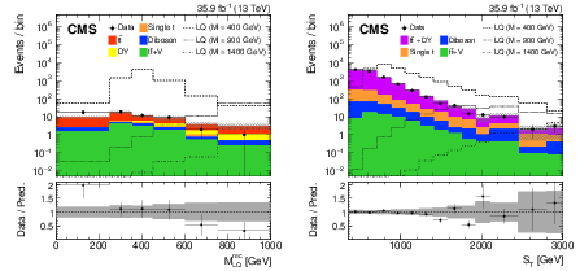
png pdf |
Figure 1:
Distributions for ${M_{{\mathrm {LQ}}}^{\text {rec}}}$ (category A, left) and ${S_{\mathrm {T}}}$ (category B, right) after applying the full selection and estimating the ${{\mathrm {t}\overline {\mathrm {t}}}}$ and DY+jets background contributions from data in category B. All backgrounds are normalized according to the post-fit nuisance parameters based on the corresponding SM cross sections. In the upper panels, the hatched areas correspond to the total uncertainty. In the lower panels, the gray bands indicate the total uncertainty. |
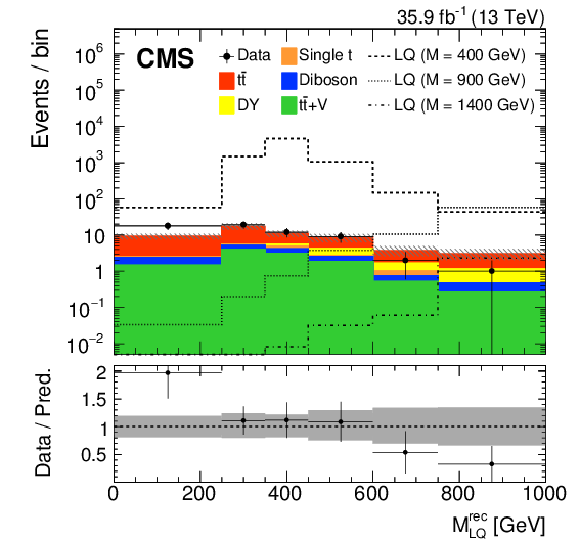
png pdf |
Figure 1-a:
Distribution for ${M_{{\mathrm {LQ}}}^{\text {rec}}}$ (category A) after applying the full selection and estimating the ${{\mathrm {t}\overline {\mathrm {t}}}}$ and DY+jets background contributions from data in category B. All backgrounds are normalized according to the post-fit nuisance parameters based on the corresponding SM cross sections. In the upper panel, the hatched area corresponds to the total uncertainty. In the lower panel, the gray band indicates the total uncertainty. |
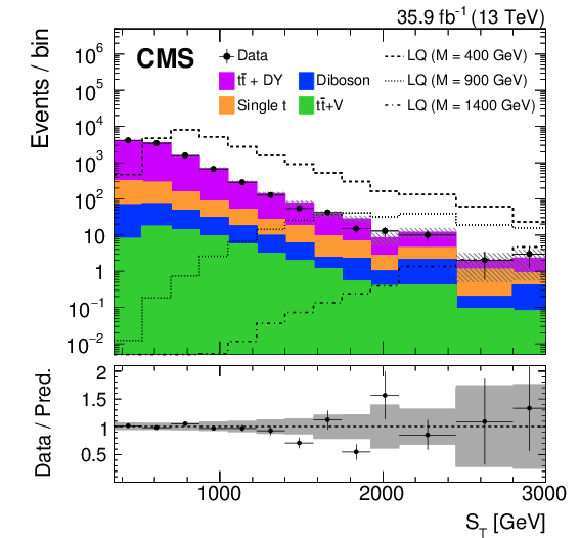
png pdf |
Figure 1-b:
Distribution for ${S_{\mathrm {T}}}$ (category B) after applying the full selection and estimating the ${{\mathrm {t}\overline {\mathrm {t}}}}$ and DY+jets background contributions from data. All backgrounds are normalized according to the post-fit nuisance parameters based on the corresponding SM cross sections. In the upper panel, the hatched area corresponds to the total uncertainty. In the lower panel, the gray band indicates the total uncertainty. |

png pdf |
Figure 2:
Observed upper limits on the production cross section for pair production of LQs decaying into a top quark and a muon or a $\tau $ lepton (left) and LQs decaying into a top quark and a muon or into a bottom quark and a neutrino (right) at 95% CL in the ${M_{{\mathrm {LQ}}}} $-$ {\mathcal {B}({{\mathrm {LQ}} \to {\mathrm {t}}\mu})}$ plane. The lines show the lower mass exclusion limits for scalar (black) and vector (colored) LQs. They are derived by using the prediction for the scalar and vector LQ signal calculated at NLO [48] and LO [49], respectively. |
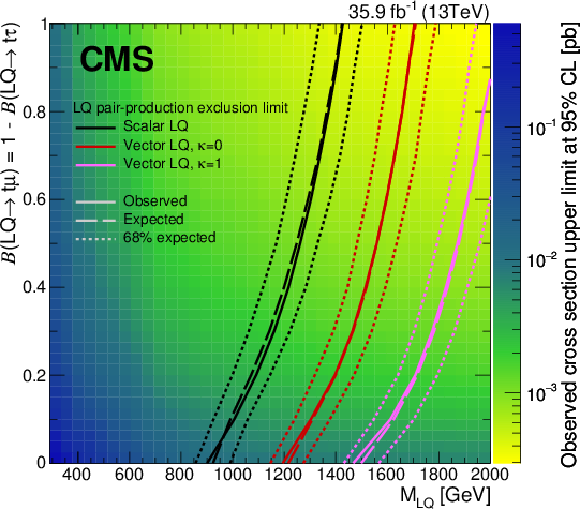
png pdf |
Figure 2-a:
Observed upper limits on the production cross section for pair production of LQs decaying into a top quark and a muon or a $\tau $ lepton at 95% CL in the ${M_{{\mathrm {LQ}}}} $-$ {\mathcal {B}({{\mathrm {LQ}} \to {\mathrm {t}}\mu})}$ plane. The lines show the lower mass exclusion limits for scalar (black) and vector (colored) LQs. They are derived by using the prediction for the scalar and vector LQ signal calculated at NLO [48] and LO [49], respectively. |
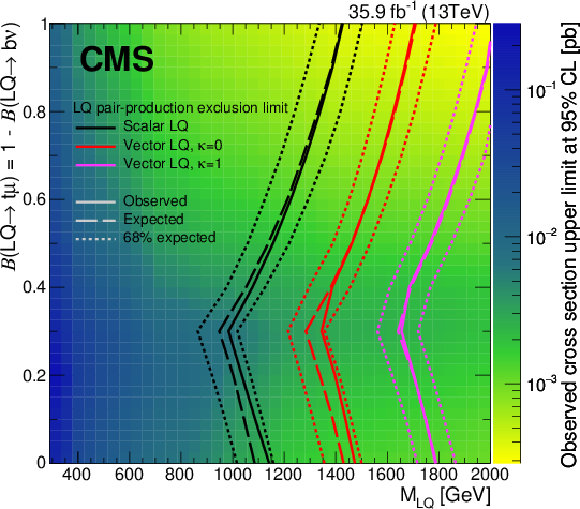
png pdf |
Figure 2-b:
Observed upper limits on the production cross section for pair production of LQs decaying into a top quark and a muon or into a bottom quark and a neutrino at 95% CL in the ${M_{{\mathrm {LQ}}}} $-$ {\mathcal {B}({{\mathrm {LQ}} \to {\mathrm {t}}\mu})}$ plane. The lines show the lower mass exclusion limits for scalar (black) and vector (colored) LQs. They are derived by using the prediction for the scalar and vector LQ signal calculated at NLO [48] and LO [49], respectively. |
| Summary |
| In summary, this analysis represents the first search for leptoquarks (LQs) decaying to top quarks and muons, reaching LQ masses of $\mathcal{O}$(1 TeV) and placing direct constraints on the corresponding LQ coupling, thus probing the region of interest of models including LQs. With this result, all relevant couplings of LQs with an electric charge of $-1/3$ to third-generation quarks are examined for the first time. |
| Additional Figures | |

png pdf |
Additional Figure 1:
Observed and expected upper limits on the production cross section for pair production of LQs decaying into a top quark and a muon at 95% CL as a function of the LQ mass. The theory predictions show the pair production cross sections for scalar (black) and vector (colored) LQs, where the acceptance for both types of LQs is similar. |

png pdf |
Additional Figure 2:
Observed upper limits on the production cross section for pair production of LQs decaying to a top quark and a muon or a tau lepton at 95% CL in the $M_{\mathrm {LQ}}$--$\mathcal {B}(\mathrm {LQ}\to {\mathrm {t}}+\mu)$ plane. The lines show the lower mass exclusion limits for scalar LQs from the $ {\mathrm {t}}$+$\tau $ channel alone (red) and the combination (black). |
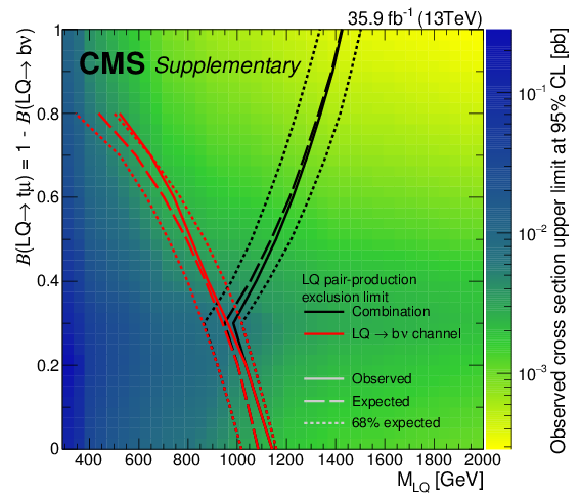
png pdf |
Additional Figure 3:
Observed upper limits on the production cross section for pair production of LQs decaying into a top quark and a muon or into a bottom quark and a neutrino at 95% CL in the $M_{\mathrm {LQ}}$--$\mathcal {B}(\mathrm {LQ}\to {\mathrm {t}}+\mu)$ plane. The lines show the lower mass exclusion limits for scalar LQs from the b+$\nu $ channel alone (red) and the combination (black). |
| References | ||||
| 1 | BaBar Collaboration | Evidence for an excess of $ \bar{B} \to D^{(*)} \tau^-\bar{\nu}_\tau $ decays | PRL 109 (2012) 101802 | 1205.5442 |
| 2 | BaBar Collaboration | Measurement of an excess of $ \bar{B} \to d^{(*)}\tau^- \bar{\nu}_\tau $ decays and implications for charged Higgs bosons | PRD 88 (2013) 072012 | 1303.0571 |
| 3 | Belle Collaboration | Observation of $ B^0 \rightarrow D^{*-} \tau^+ \nu_{\tau} $ decay at Belle | PRL 99 (2007) 191807 | 0706.4429 |
| 4 | Belle Collaboration | Observation of $ B^+ \rightarrow \bar{D}^{*0} \tau^+ \nu_{\tau} $ and evidence for $ B^+ \rightarrow \bar{D}^0 \tau^+ \nu_{\tau} $ at Belle | PRD 82 (2010) 072005 | 1005.2302 |
| 5 | Belle Collaboration | Measurement of the branching ratio of $ \bar{B} \to D^{(\ast)} \tau^- \bar{\nu}_\tau $ relative to $ \bar{B} \to D^{(\ast)} \ell^- \bar{\nu}_\ell $ decays with hadronic tagging at Belle | PRD 92 (2015) 072014 | 1507.03233 |
| 6 | LHCb Collaboration | Measurement of the ratio of branching fractions $ \mathcal{B}(\bar{B}^0 \to D^{*+}\tau^{-}\bar{\nu}_{\tau})/\mathcal{B}(\bar{B}^0 \to D^{*+}\mu^{-}\bar{\nu}_{\mu}) $ | PRL 115 (2015) 111803 | 1506.08614 |
| 7 | LHCb Collaboration | Test of lepton flavor universality by the measurement of the $ B^0 \to D^{*-} \tau^+ \nu_{\tau} $ branching fraction using three-prong $ \tau $ decays | PRD 97 (2018) 072013 | 1711.02505 |
| 8 | HFLAV Collaboration | Averages of $ b $-hadron, $ c $-hadron, and $ \tau $-lepton properties as of summer 2016 | EPJC 77 (2017) 895 | 1612.07233 |
| 9 | LHCb Collaboration | Test of lepton universality using $ B^{+}\to K^{+}\ell^{+}\ell^{-} $ decays | PRL 113 (2014) 151601 | 1406.6482 |
| 10 | LHCb Collaboration | Differential branching fractions and isospin asymmetries of $ B \to K^{(*)} \mu^+ \mu^- $ decays | JHEP 06 (2014) 133 | 1403.8044 |
| 11 | LHCb Collaboration | Angular analysis of the $ B^{0} \to K^{*0} \mu^{+}\mu^{-} $ decay using 3$ fb$^{-1} of integrated luminosity | JHEP 02 (2016) 104 | 1512.04442 |
| 12 | LHCb Collaboration | Test of lepton universality with $ B^{0} \to K^{*0}\ell^{+}\ell^{-} $ decays | JHEP 08 (2017) 055 | 1705.05802 |
| 13 | Muon g-2 Collaboration | Final report of the muon E821 anomalous magnetic moment measurement at BNL | PRD 73 (2006) 072003 | hep-ex/0602035 |
| 14 | M. Davier, A. Hoecker, B. Malaescu, and Z. Zhang | Reevaluation of the hadronic vacuum polarisation contributions to the standard model predictions of the muon $ g-2 $ and $ \alpha (m_Z^2) $ using newest hadronic cross-section data | EPJC 77 (2017) 827 | 1706.09436 |
| 15 | M. Tanaka and R. Watanabe | New physics in the weak interaction of $ \bar B \to D^{(*)}\tau\bar\nu $ | PRD 87 (2013) 034028 | 1212.1878 |
| 16 | Y. Sakaki, M. Tanaka, A. Tayduganov, and R. Watanabe | Testing leptoquark models in $ \bar B \to D^{(*)} \tau \bar\nu $ | PRD 88 (2013) 094012 | 1309.0301 |
| 17 | I. Dor$\text\us$ner, S. Fajfer, N. Ko$\text\us$nik, and I. Ni$\text\us$and$\text\vz$i\'c | Minimally flavored colored scalar in $ \bar B \to D^{(*)} \tau \bar \nu $ and the mass matrices constraints | JHEP 11 (2013) 084 | 1306.6493 |
| 18 | B. Dumont, K. Nishiwaki, and R. Watanabe | LHC constraints and prospects for $ S_1 $ scalar leptoquark explaining the $ \bar B \to D^{(*)} \tau \bar\nu $ anomaly | PRD 94 (2016) 034001 | 1603.05248 |
| 19 | A. Crivellin, D. Muller, and T. Ota | Simultaneous explanation of $ R(D^{(*)}) $ and $ \mathrm{b}\to\mathrm{s}\mu^{+}\mu^{-} $: the last scalar leptoquarks standing | JHEP 09 (2017) 040 | 1703.09226 |
| 20 | B. Gripaios, M. Nardecchia, and S. A. Renner | Composite leptoquarks and anomalies in $ b $-meson decays | JHEP 05 (2015) 006 | 1412.1791 |
| 21 | M. Bauer and M. Neubert | Minimal leptoquark explanation for the $ R_{D^{(*)}} $, $ R_K $ , and $ (g-2)_\mu $ anomalies | PRL 116 (2016) 141802 | 1511.01900 |
| 22 | E. Coluccio Leskow, G. D'Ambrosio, A. Crivellin, and D. Muller | $ (g-2)_\mu $, lepton flavor violation, and Z decays with leptoquarks: Correlations and future prospects | PRD 95 (2017) 055018 | 1612.06858 |
| 23 | D. Be$\text\uc$irevi\'c and O. Sumensari | A leptoquark model to accommodate $ R_K^\mathrm{exp} < R_K^\mathrm{SM} $ and $ R_{K^\ast}^\mathrm{exp} < R_{K^\ast}^\mathrm{SM} $ | JHEP 08 (2017) 104 | 1704.05835 |
| 24 | G. Hiller and I. Ni$\text\us$and$\text\vz$i\'c | $ R_K $ and $ R_{K^{\ast}} $ beyond the standard model | PRD 96 (2017) 035003 | 1704.05444 |
| 25 | G. Hiller, D. Loose, and I. Ni$\text\us$and$\text\vz$i\'c | Flavorful leptoquarks at hadron colliders | PRD 97 (2018) 075004 | 1801.09399 |
| 26 | J. C. Pati and A. Salam | Lepton number as the fourth color | PRD 10 (1974) 275, .[Erratum: \DOI10.1103/PhysRevD.11.703.2] | |
| 27 | H. Georgi and S. L. Glashow | Unity of all elementary-particle forces | PRL 32 (1974) 438 | |
| 28 | H. Fritzsch and P. Minkowski | Unified interactions of leptons and hadrons | Annals Phys. 93 (1975) 193 | |
| 29 | E. Farhi and L. Susskind | Technicolor | PR 74 (1981) 277 | |
| 30 | K. Lane and M. V. Ramana | Walking technicolor signatures at hadron colliders | PRD 44 (1991) 2678 | |
| 31 | B. Schrempp and F. Schrempp | Light leptoquarks | PLB 153 (1985) 101 | |
| 32 | B. Gripaios | Composite leptoquarks at the LHC | JHEP 02 (2010) 045 | 0910.1789 |
| 33 | W. Buchmuller, R. Ruckl, and D. Wyler | Leptoquarks in lepton - quark collisions | PLB 191 (1987) 442 | |
| 34 | D. E. Acosta and S. K. Blessing | Leptoquark searches at HERA and the Tevatron | Ann. Rev. Nucl. Part. Sci. 49 (1999) 389 | |
| 35 | CMS Collaboration | Search for third-generation scalar leptoquarks in the t$ \tau $ channel in proton-proton collisions at $ \sqrt{s}= $ 8 TeV | JHEP 07 (2015) 042 | CMS-EXO-14-008 1503.09049 |
| 36 | D0 Collaboration | Search for third-generation leptoquarks in $ \mathrm{p} \bar{\mathrm{p}} $ collisions at $ \sqrt{s} = $ 1.96 TeV | PRL 99 (2007) 061801 | 0705.0812 |
| 37 | CDF Collaboration | Search for third generation vector leptoquarks in $ \mathrm{p}\bar{\mathrm{p}} $ collisions at $ \sqrt{s} = $ 1.96 TeV | PRD 77 (2008) 091105 | 0706.2832 |
| 38 | ATLAS Collaboration | Search for third generation scalar leptoquarks in pp collisions at $ \sqrt{s} = $ 7 TeV with the ATLAS detector | JHEP 06 (2013) 033 | 1303.0526 |
| 39 | CMS Collaboration | Search for third-generation leptoquarks and scalar bottom quarks in pp collisions at $ \sqrt{s}= $ 7 TeV | JHEP 12 (2012) 055 | CMS-EXO-11-030 1210.5627 |
| 40 | CMS Collaboration | Search for pair production of third-generation scalar leptoquarks and top squarks in proton-proton collisions at $ \sqrt{s} = $ 8 TeV | PLB 739 (2014) 229 | CMS-EXO-12-032 1408.0806 |
| 41 | CMS Collaboration | Searches for third-generation squark production in fully hadronic final states in proton-proton collisions at $ \sqrt{s} = $ 8 TeV | JHEP 06 (2015) 116 | CMS-SUS-14-001 1503.08037 |
| 42 | ATLAS Collaboration | Searches for scalar leptoquarks in pp collisions at $ \sqrt{s} = $ 8 TeV with the ATLAS detector | EPJC 76 (2016) 5 | 1508.04735 |
| 43 | CMS Collaboration | Search for heavy neutrinos or third-generation leptoquarks in final states with two hadronically decaying $ \tau $ leptons and two jets in proton-proton collisions at $ \sqrt{s}= $ 13 TeV | JHEP 03 (2017) 077 | CMS-EXO-16-016 1612.01190 |
| 44 | CMS Collaboration | Search for third-generation scalar leptoquarks and heavy right-handed neutrinos in final states with two tau leptons and two jets in proton-proton collisions at $ \sqrt{s}= $ 13 TeV | JHEP 07 (2017) 121 | CMS-EXO-16-023 1703.03995 |
| 45 | CMS Collaboration | Search for new phenomena with the $ M_{\mathrm {T2}} $ variable in the all-hadronic final state produced in proton-proton collisions at $ \sqrt{s} = $ 13 TeV | EPJC 77 (2017) 710 | CMS-SUS-16-036 1705.04650 |
| 46 | CMS Collaboration | Search for third-generation scalar leptoquarks decaying to a top quark and a $ \tau $ lepton at $ \sqrt{s}= $ 13 TeV | EPJC 78 (2018) 707 | CMS-B2G-16-028 1803.02864 |
| 47 | CMS Collaboration | Constraints on models of scalar and vector leptoquarks decaying to a quark and a neutrino at $ \sqrt{s}= $ 13 TeV | PRD 98 (2018) 032005 | CMS-SUS-18-001 1805.10228 |
| 48 | M. Kramer, T. Plehn, M. Spira, and P. M. Zerwas | Pair production of scalar leptoquarks at the CERN LHC | PRD 71 (2005) 057503 | hep-ph/0411038 |
| 49 | I. Dor$\text\us$ner and A. Greljo | Leptoquark toolbox for precision collider studies | JHEP 05 (2018) 126 | 1801.07641 |
| 50 | CMS Collaboration | The CMS experiment at the CERN LHC | JINST 3 (2008) S08004 | CMS-00-001 |
| 51 | CMS Collaboration | The CMS trigger system | JINST 12 (2017) P01020 | CMS-TRG-12-001 1609.02366 |
| 52 | T. Sjostrand, S. Mrenna, and P. Z. Skands | PYTHIA 6.4 physics and manual | JHEP 05 (2006) 026 | hep-ph/0603175 |
| 53 | T. Sjostrand et al. | An introduction to PYTHIA 8.2 | CPC 191 (2015) 159 | 1410.3012 |
| 54 | P. Nason | A new method for combining NLO QCD with shower Monte Carlo algorithms | JHEP 11 (2004) 040 | hep-ph/0409146 |
| 55 | S. Frixione, P. Nason, and C. Oleari | Matching NLO QCD computations with parton shower simulations: the POWHEG method | JHEP 11 (2007) 070 | 0709.2092 |
| 56 | S. Alioli, P. Nason, C. Oleari, and E. Re | A general framework for implementing NLO calculations in shower Monte Carlo programs: the POWHEG BOX | JHEP 06 (2010) 043 | 1002.2581 |
| 57 | S. Frixione, P. Nason, and G. Ridolfi | A positive-weight next-to-leading-order Monte Carlo for heavy flavour hadroproduction | JHEP 09 (2007) 126 | 0707.3088 |
| 58 | T. Melia, P. Nason, R. Rontsch, and G. Zanderighi | W$ ^+ $W$ ^- $, WZ and ZZ production in the POWHEG BOX | JHEP 11 (2011) 078 | 1107.5051 |
| 59 | P. Nason and G. Zanderighi | $ \mathrm{W}^+ \mathrm{W}^- $ , WZ and ZZ production in the POWHEG-BOX-V2 | EPJC 74 (2014) 2702 | 1311.1365 |
| 60 | S. Alioli, P. Nason, C. Oleari, and E. Re | NLO single-top production matched with shower in POWHEG: $ s $- and $ t $-channel contributions | JHEP 09 (2009) 111 | 0907.4076 |
| 61 | E. Re | Single-top Wt-channel production matched with parton showers using the POWHEG method | EPJC 71 (2011) 1547 | 1009.2450 |
| 62 | J. Alwall et al. | The automated computation of tree-level and next-to-leading order differential cross sections, and their matching to parton shower simulations | JHEP 07 (2014) 079 | 1405.0301 |
| 63 | R. Frederix and S. Frixione | Merging meets matching in MC@NLO | JHEP 12 (2012) 061 | 1209.6215 |
| 64 | J. Alwall et al. | Comparative study of various algorithms for the merging of parton showers and matrix elements in hadronic collisions | EPJC 53 (2008) 473 | 0706.2569 |
| 65 | NNPDF Collaboration | Parton distributions for the LHC Run II | JHEP 04 (2015) 040 | 1410.8849 |
| 66 | CMS Collaboration | Investigations of the impact of the parton shower tuning in PYTHIA 8 in the modelling of $ \mathrm{t\overline{t}} $ at $ \sqrt{s}= $ 8 and 13 TeV | CMS-PAS-TOP-16-021 | CMS-PAS-TOP-16-021 |
| 67 | CMS Collaboration | Event generator tunes obtained from underlying event and multiparton scattering measurements | EPJC 76 (2016) 155 | CMS-GEN-14-001 1512.00815 |
| 68 | P. Skands, S. Carrazza, and J. Rojo | Tuning PYTHIA 8.1: the Monash 2013 Tune | EPJC 74 (2014) 3024 | 1404.5630 |
| 69 | GEANT4 Collaboration | GEANT4--a simulation toolkit | NIMA 506 (2003) 250 | |
| 70 | J. Allison et al. | GEANT4 developments and applications | IEEE Trans. Nucl. Sci. 53 (2006) 270 | |
| 71 | CMS Collaboration | Particle-flow reconstruction and global event description with the CMS detector | JINST 12 (2017) P10003 | CMS-PRF-14-001 1706.04965 |
| 72 | M. Cacciari, G. P. Salam, and G. Soyez | The anti-$ {k_{\mathrm{T}}} $ jet clustering algorithm | JHEP 04 (2008) 063 | 0802.1189 |
| 73 | M. Cacciari, G. P. Salam, and G. Soyez | FastJet user manual | EPJC 72 (2012) 1896 | 1111.6097 |
| 74 | CMS Collaboration | Technical Proposal for the Phase-II upgrade of the Compact Muon Solenoid | CMS-PAS-TDR-15-002 | CMS-PAS-TDR-15-002 |
| 75 | CMS Collaboration | Performance of the CMS muon detector and muon reconstruction with proton-proton collisions at $ \sqrt{s}= $ 13 TeV | JINST 13 (2018) P06015 | CMS-MUO-16-001 1804.04528 |
| 76 | CMS Collaboration | Performance of photon reconstruction and identification with the CMS detector in proton-proton collisions at $ \sqrt{s} = $ 8 TeV | JINST 10 (2015) P08010 | CMS-EGM-14-001 1502.02702 |
| 77 | CMS Collaboration | Jet energy scale and resolution in the CMS experiment in pp collisions at 8 TeV | JINST 12 (2017) P02014 | CMS-JME-13-004 1607.03663 |
| 78 | CMS Collaboration | Identification of heavy-flavour jets with the CMS detector in pp collisions at 13 TeV | JINST 13 (2018) P05011 | CMS-BTV-16-002 1712.07158 |
| 79 | J. Butterworth et al. | PDF4LHC recommendations for LHC Run II | JPG 43 (2016) 023001 | 1510.03865 |
| 80 | CMS Collaboration | Measurement of the $ \mathrm{t\bar{t}} $ production cross section using events in the e$ \mu $ final state in pp collisions at $ \sqrt{s} = $ 13 TeV | EPJC 77 (2017) 172 | CMS-TOP-16-005 1611.04040 |
| 81 | CMS Collaboration | Measurement of inclusive W and Z boson production cross sections in pp collisions at $ \sqrt{s} = $ 8 TeV | PRL 112 (2014) 191802 | CMS-SMP-12-011 1402.0923 |
| 82 | CMS Collaboration | Cross section measurement of $ t $-channel single top quark production in pp collisions at $ \sqrt s = $ 13 TeV | PLB 772 (2017) 752 | CMS-TOP-16-003 1610.00678 |
| 83 | N. Kidonakis | NNLL threshold resummation for top-pair and single-top production | Phys. Part. Nucl. 45 (2014) 714 | 1210.7813 |
| 84 | CMS Collaboration | Observation of the associated production of a single top quark and a W boson in pp collisions at $ \sqrt s = $ 8 TeV | PRL 112 (2014) 231802 | CMS-TOP-12-040 1401.2942 |
| 85 | T. Gehrmann et al. | $ \mathrm{W}^+\mathrm{W}^- $ production at hadron colliders in next to next to leading order QCD | PRL 113 (2014) 212001 | 1408.5243 |
| 86 | J. M. Campbell, R. K. Ellis, and C. Williams | Vector boson pair production at the LHC | JHEP 07 (2011) 018 | 1105.0020 |
| 87 | CMS Collaboration | Measurement of the WZ production cross section in pp collisions at $ \sqrt s = $ 13 TeV | PLB 766 (2017) 268 | CMS-SMP-16-002 1607.06943 |
| 88 | CMS Collaboration | Measurement of the cross section for top quark pair production in association with a W or Z boson in proton-proton collisions at $ \sqrt{s}= $ 13 TeV | JHEP 08 (2018) 011 | CMS-TOP-17-005 1711.02547 |
| 89 | CMS Collaboration | CMS luminosity measurements for the 2016 data taking period | CMS-PAS-LUM-17-001 | CMS-PAS-LUM-17-001 |
| 90 | CMS Collaboration | Measurement of the inelastic proton-proton cross section at $ \sqrt{s}= $ 13 TeV | JHEP 07 (2018) 161 | CMS-FSQ-15-005 1802.02613 |
| 91 | J. Ott | Theta --- A framework for template-based modeling and inference | 2010 \url http://www-ekp.physik.uni-karlsruhe.de/\ ott/theta/theta-auto | |
| 92 | A. O'Hagan and J. J. Forster | Kendall's advanced theory of statistics. Vol. 2B: Bayesian Inference | Arnold, London | |
| 93 | G. Cowan, ``Statistics'', Ch. 39 in Particle Data Group | Statistics'', Ch. 39 in Particle Data Group, ``Review of particle physics | CPC 40 (2016) 100001 | |

|
Compact Muon Solenoid LHC, CERN |

|

|

|

|

|

|